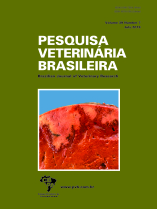 |
|
|
|
Year 2019 - Volume 39, Number 7
|

|
Use of infrared thermography in Quarter Horse submitted to team roping, 39(7):530-537
|
ABSTRACT.- Gerardi B., Denadai D.S., Pereira M.S., Chaves A.A., Barbosa J.P.B., Peiró J.R., Feitosa F.L.F. & Mendes L.C.N. 2019. Use of infrared thermography in Quarter Horse submitted to team roping. [Uso da termografia infravermelha em equinos da raça Quarto de Milha submetidos à prova de laço em dupla.] Pesquisa Veterinária Brasileira 39(7):530-537. Departamento de Clínica, Cirurgia e Reprodução Animal, Universidade Estadual Paulista “Julio de Mesquita Filho”, Campus de Araçatuba, Rua Clóvis Pestana 793, Araçatuba, SP 16050-680, Brazil. E-mail: bi_gerardi@hotmail.com
This study aimed to verify whether the body and local temperatures change after high-intensity, short-duration exercise (team roping) and whether different pieces of training influence these changes. To this end, twelve animals, males and females, aged 3-6 years, with an average weight of 450 kg, were used. The horses were divided into two groups: regular training (RTG) and sporadic training (STG). The surface temperatures were assessed using a specific thermal camera. Temperatures of the ocular, thoracolumbar, distal tendon (thoracic and pelvic limbs) and croup regions were measured 30 min before, immediately after, and one, two, six and 24 hours after competition simulation. In the RTG, there was an increase in surface eye temperature two hours after exercise, returning to baseline level 24 hours later. In the STG, increase in eye temperature occurred immediately after exercise and returned to baseline level two hours later. Temperature of the pelvic limb tendons and croup (right side) rose immediately after exercise and did not return to baseline level 24 hours later. Team roping exercise increased the surface temperature of the distolateral thoracic and pelvic limb, croup and thoracolumbar regions in both groups and the eye temperature in the STG. Training frequency influenced the surface temperature profile in the distolateral pelvic limb, croup and thoracolumbar regions. |
| |
|
|
| |
|
 |